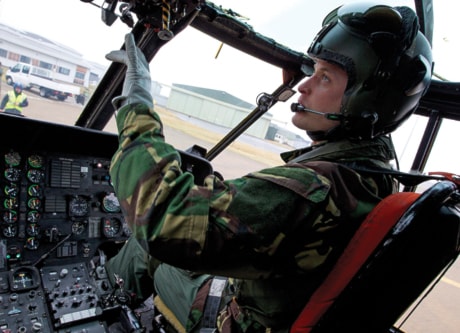ANGLESEY, Wales — Dense fog curled around the snowcapped Welsh mountains and fierce winds rattled the cockpit of the military rescue helicopter.
At the controls, plotting the best path to a stranded heart attack victim, was a newly engaged air force co-pilot.
Prince William — or Flight Lt. Wales, as he is known to his Royal Air Force colleagues — pushed his Sea King aircraft through the gloom, swooping low so 45-year-old Greg Watkins could be winched from the hillside and raced to a hospital.
The mission last November — two days after the prince and Kate Middleton announced plans to marry — is typical of the sometimes-risky rescues performed by the king-to-be in his unlikely day job: patrolling Britain’s coast with a military search squadron.
Britain’s monarchy has an enduring connection to the armed forces — William is part of the fourth successive generation to have served as a pilot. His grandmother, Queen Elizabeth II, is the military’s ceremonial chief and joined the Women’s Auxiliary Territorial Service during World War II, reaching the rank of junior commander and training as a driver.
Yet the reality of modern conflicts — complete with battlefield kidnappings and grisly Internet videos — means that William’s combat ambitions are almost certain to go unfulfilled.
The 28-year-old has repeatedly aired his frustration that military chiefs have barred him from serving in Afghanistan, dismissing as “hyped up” the belief that — as a future king — he would be a prime target for insurgents.
“It’s just a pity I didn’t get to Afghanistan,” William said last year. “I still have hope and faith and a real determination to go out there.”
The last monarch to eyeball the enemy in conflict was his great-grandfather King George VI, who fought in the Battle of Jutland during World War I. George, however, was not destined for the throne at the time, only later thrust into the role following his elder brother Edward’s abdication.
“While Prince William, I know, would love to have had the opportunity to serve in Afghanistan, there is no doubt that there are risks that surface out there,” Gen. David Richards, the head of the British military, said last year.
Though Prince William did make a brief stop in 2008 at an air base in Kandahar, Afghanistan, it is younger brother Prince Harry, third-in-line to the throne, who has joined British personnel in clashes against the Taliban.
Harry served a 10-week tour in Afghanistan’s southern Helmand province as a battlefield air controller, but was abruptly removed in February 2008 after a media blackout was breached and the prince’s safety was judged to be in jeopardy.
A year earlier, Harry had abandoned plans to fight in Iraq after British intelligence learned of threats by militants to kill him.
While Harry is expected to return to Afghanistan later this year — this time at the controls of an Apache attack helicopter, William will be guiding rescue sorties from RAF Valley, his base in a remote corner of northern Wales.
“It’s great to get to go out to save somebody’s life hopefully, or at least make a difference to someone,” William said earlier this month as he showed the queen around the station on the island of Anglesey.
“When you know that they are in trouble, you do everything you can to try and get there,” he explained.
William, second-in-line to the British throne, carried out his first mission in October, plucking a stricken worker from a gas rig off the coast of northwestern England.
William’s father Prince Charles served with the Royal Navy — briefly commanding a minehunter, and also qualified as a jet pilot. During a 22-year naval career, William’s uncle, the Duke of York, flew combat missions during the 1982 Falklands war with Argentina over Britain’s disputed South Atlantic colony.
The Duke of Edinburgh, William’s grandfather, served for more than a decade in the Royal Navy — including during World War II.
Like his grandfather, William’s military career is likely to be curtailed by regal duties. Philip left active service in 1952 when the queen took her throne, and most observers suspect the prince will hang up his pilot’s helmet when Charles becomes king — if not earlier.
Before then, William will serve about two-and-a-half more years as a rescue pilot in Anglesey, allowing the royal newlyweds to spend the first months of their marriage in a discreet corner of Britain. The couple now rent a whitewashed farmhouse close to a private beach, and away from snooping camera lenses.
His love for Middleton has sometimes got pilot William in hot water. In 2008, William made a surprise visit to Middleton’s childhood home in the southern England village of Bucklebury — waving from the cockpit of his Chinook helicopter, after he rerouted a training flight to briefly touch down in one of her family’s fields.
His superiors in the Royal Air Force were, suffice to say, rather upset.
